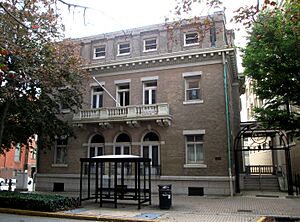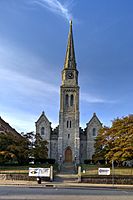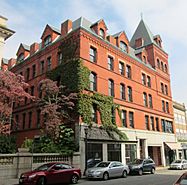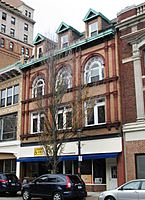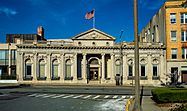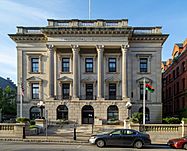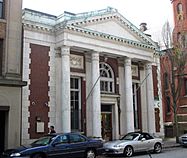Downtown New London Historic District facts for kids
|
Downtown New London Historic District
|
|
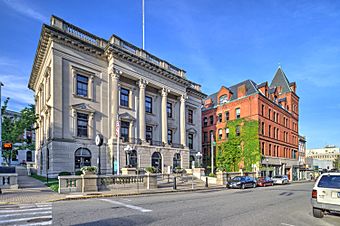
State Street: Municipal Building and J.N. Harris Building (aka Lena Building)
|
|
| Location | Roughly bounded by State, Bank, Tilley and Washington Sts. (original); along Huntington, Washington and Jay Sts.; SW corner of Meridan and Gov. Winthrop Blvd.; along Bank and Sparyard Sts. (boundary increase) New London, Connecticut |
|---|---|
| Area | 60 acres (24 ha) (original) 18 acres (7.3 ha) (increase) |
| Architect | multiple |
| Architectural style | multiple |
| NRHP reference No. | 79002665 (original) 88000070 (increase) |
Quick facts for kids Significant dates |
|
| Added to NRHP | April 13, 1979 |
| Boundary increase | February 18, 1988 |
The Downtown New London Historic District is a special area in New London, Connecticut. It's also called the Waterfront Historic District. This district covers about 78 acres and has 223 important buildings. These buildings are along the city's waterfront.
This historic district was added to the National Register of Historic Places (NRHP) in 1979. At that time, it included 190 buildings and covered about 60 acres. Later, in 1988, the district grew. Another 18 acres and 33 buildings were added to this important historical area.
Contents
Exploring New London's Historic Waterfront
New London's downtown area has a rich history. Many buildings here tell stories from long ago. This section will guide you through some of the most interesting parts of the district.
Bank Street: A Historic Waterfront Walk
Bank Street gets its name because it sits on the bank of the Thames River. This is one of the oldest parts of New London. Long ago, it was busy with fishing boats and large sailing ships.
In 1781, during the American Revolutionary War, Benedict Arnold led British forces through New London. They burned much of the city. But the waterfront was rebuilt after this event. The road was even raised to make room for more buildings and bigger ships.
Today, Bank Street is a lively place. You can find restaurants, cafes, and shops here. It also has some very old buildings from the 1700s, including:
- The Shaw Mansion, built in 1753. This building was the headquarters for Connecticut's Navy during the American Revolution.
- Bukeley House, built in 1796. The first owner of this house served with the famous sailor John Paul Jones.
Bank Street also features important buildings from the 1800s:
- The New London Customhouse, built in 1833. This is the oldest custom house in the United States that has been used continuously.
- The Brown House at 258 Bank Street. Built in 1833, this house used the same granite as the Custom House.
- The area also includes the site related to the ship La Amistad. This ship was involved in a famous legal case about freedom.
State Street: A Journey Through Time
State Street runs from Huntington Street to Water Street. It is mostly lined with buildings from the 1800s. However, there are a few older exceptions.
The 1787 New London County Courthouse is at the top of State Street. It's a very old building, but it's not part of this historic district. The 1740 Timothy Green printing studio is also nearby. The 1774 Nathan Hale School House was once on State Street. It has since been moved to Atlantic Street.
State Street is home to many notable buildings:
- First Church of Christ (Congregational), built in 1850. This church has a beautiful Gothic Revival style.
- The First Baptist Church at 268 State Street, built in 1856. It was designed in the Italianate style.
- Harris Place (1885) at 159 State Street. This building had offices, apartments, and a department store.
- Lyric Hall (1898) at 243 State Street. This building had a small theater for lectures and performances.
- The Thames Club (1905) at 290 State Street.
- The New London Municipal Building (1912) at 181 State Street. This building has a grand Beaux-Arts style.
- A Greek Revival bank building at 250 State Street, built in 1930.
- The Lena Building, originally known as the J.N. Harris Building, built in 1884-1885.
- The New London Public Library is also on State Street. It was built in 1889-92 and has a Richardsonian Romanesque style.
Green Street is also part of the downtown historic area. It was officially laid out in 1787. Many buildings here date from 1760-1792. These buildings survived the fires set by Benedict Arnold. Dutch's Tavern, a favorite spot of writer Eugene O'Neill, is in a 1760 building. The home at 79 Green Street, built around 1801, is known as The Richard Douglass House. Richard Douglass was a soldier in the American Revolution.
The Starr Street District is nearby. It has a group of row houses built in the early 1800s. The New London Railroad Station is also in the area. Like the Courthouse, it is listed separately on the NRHP.
Images for kids




